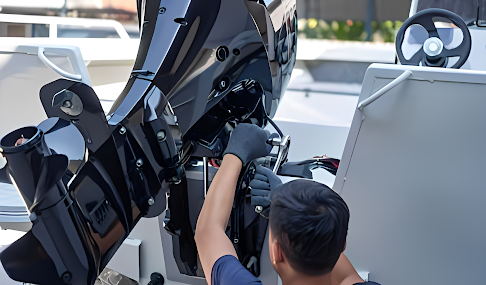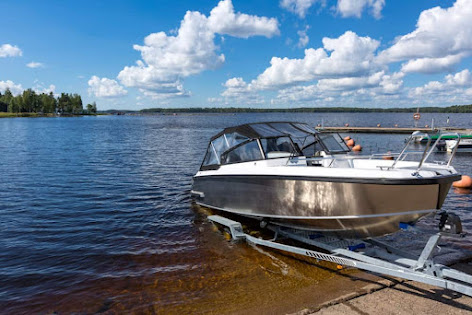Self-leveling Tabs vs. Electric Trim Tabs: A Comprehensive Comparison
Boat owners and enthusiasts are constantly looking for ways to improve the performance of their vessel on the water. One major component that can significantly affect a boat's stability and handling is trim tabs.
Trim tabs are adjustable surfaces that are usually mounted on the transom of a
boat to control its balance and improve its running behavior. In recent years,
two main types of trim tabs have gained popularity – self-leveling trim tabs
and electric trim tabs. In this article, we will dive into the features,
benefits, and limitations of each type to help you make an informed decision
about your boating needs.
Self-leveling Trim Tabs
Self-leveling trim tabs, also known as automatic trim tabs,
are designed to automatically set and maintain your boat's trim. These tabs use
sophisticated technology and sensors to constantly monitor the ship's position
and make adjustments in real time. Here are some key points to take into
consideration when evaluating self-leveling trim tabs:
AUTO-LEVELING
Self-leveling trim tabs
eliminate the need for manual adjustments, making them incredibly convenient
for boat operators. They respond to changes in boat speed and weight
distribution, keeping your boat level and improving fuel efficiency.
IMPROVED FUEL EFFICIENCY
By maintaining the boat's optimal operating position, self-leveling trim tabs can significantly improve fuel efficiency, as the vessel moves through the water with less resistance.
ENHANCED RIDE COMFORT
These trim lugs provide
a smoother ride by reducing bow height and minimizing wind and wave effects.
Passengers are less likely to feel discomfort due to sudden changes in the
position of the boat.
Ease of Use: Self-leveling trim markers are
generally easy to use and require minimal interaction. Once fitted and
calibrated, they operate independently, allowing the operator to focus on other
aspects of the boating.
Electrical Trim Tabs
Electric trim tabs, also known as manual trim tabs, are
controlled by the boat operator, who can adjust them as needed to achieve the
desired cut. Here are some considerations for electrical cut-off tabs:
Manual Control: Electric trim tabs require the
operator to manually adjust them. Although this allows for more accurate
control, it may be less convenient, especially when water conditions change
rapidly.
Customizability: Electric trim tabs provide
greater flexibility in adjusting the cut. Boaters can adjust the position of
the boat to suit specific conditions, such as rough water or heavy loads.
COST-EFFECTIVE OPTION: Electric trim tabs
are generally less expensive to purchase and install than self-leveling cut-off
tabs, making them an attractive option for budget-conscious boat owners.
*You can buy the trim tabs at lowest prices from CKW Store.
Maintenance: Electric trim tabs may need more maintenance, as they include moving mechanical parts that can wear out over time. Regular checks and adjustments are necessary to ensure it is working optimally.
Advanced Features of Self-leveling Trim Tabs
Self-leveling trim tabs offer a range of advanced features that can be especially beneficial to boat owners looking for top-notch performance and comfort. Here are some advanced features to take into account:
Built-in GPS and Wind Sensors: Some self-leveling tabs are equipped with an integrated GPS and wind sensor. These sensors collect real-time data on your boat's position and prevailing wind conditions, allowing the trim markers to make precise adjustments to maintain the desired trim angle.
Automatic Trim Functions: Self-leveling trim tabs often come equipped with automatic trim functions that can be customized to suit your preferences. These functions automatically adjust the cut tabs in response to changes in boat speed or weight distribution.
Remote Control and Mobile App: Some self-leveling
tab models can be controlled remotely via a dedicated remote or mobile app.
This feature enables you to adjust your boat rigging without having to access
the control panel on the rigging tab.
Addressing Common Concerns Regarding Electrical Trim Tabs
While electric trim tabs offer cost effectiveness and user
control, they also come with some common concerns that boat owners should be
aware of:
Manual Adjustments: The main concern regarding
electric trim tabs is that they require manual adjustments, which can be a
challenge in rapidly changing boating conditions. Operators need to
continuously monitor and make changes to maintain optimal trim.
Conclusion
Electric trim tabs, with their electromechanical precision,
offer a unique blend of stability and rapid response times. The use of O-ring
technology safeguards against water intrusion, providing reliability even in
demanding marine environments.
On the other side of the spectrum, hydraulic trim tabs,
powered by a hydraulic pump, tout firepower and an inherent avoidance of
electric components' water vulnerability. Yet, the placement of the hydraulic
pump introduces concerns about moisture-induced corrosion, jeopardizing
critical connections.
The choice ultimately hinges on the specific needs of the
vessel and the navigational conditions it will encounter.
To learn more about self-levelling, interceptors, hydraulic, and electric trim tabs, you can read the following articles:
| Trim Tabs vs. Interceptors: What's the Difference for My Boat? |




Comments
Post a Comment